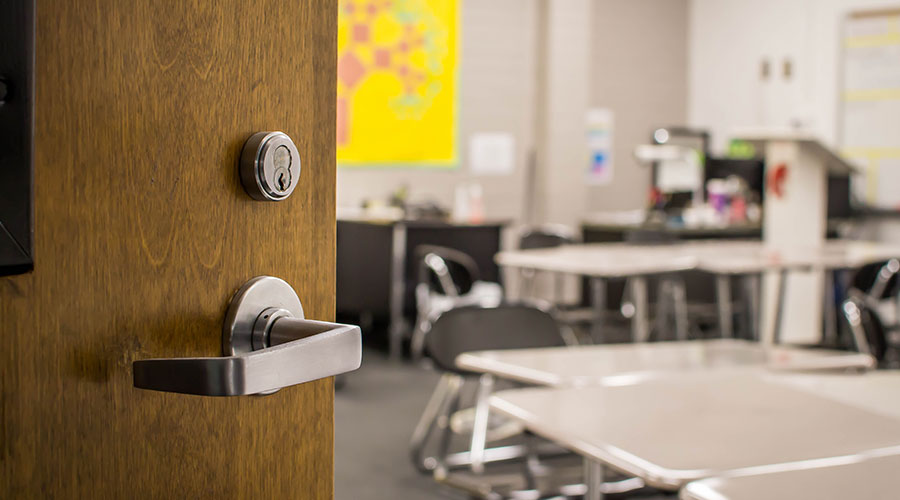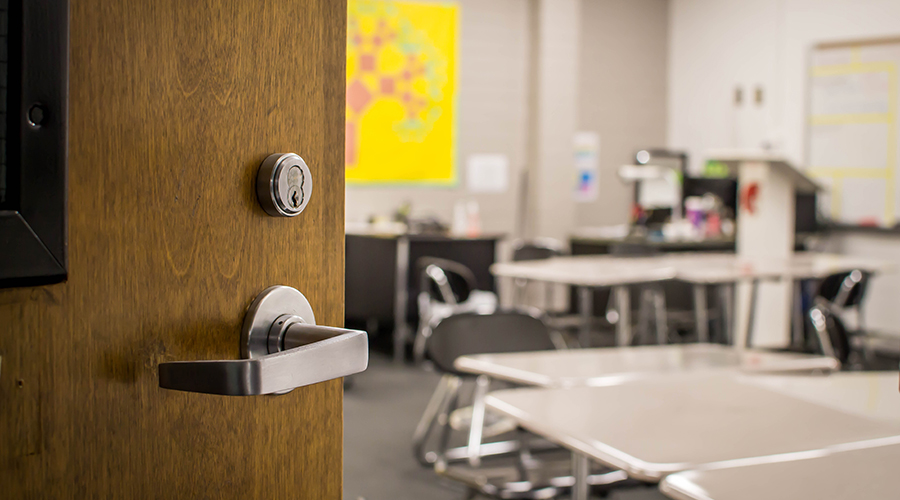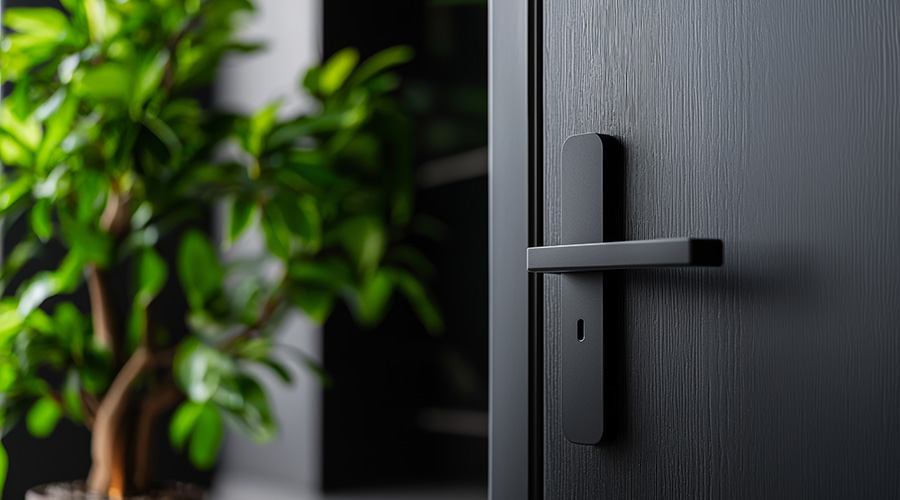Meeting New-Generation Challenges
Active shooters, COVID-19 and Big Data have affected the way managers approach decisions on doors, security and access control.
By Dan Hounsell, Senior Editor
What a difference a decade makes.
Few people could have predicted that events of the last 10 years would have such a profound impact on institutional and commercial facilities. From the COVID-19 pandemic and active shooter events to the rise of Big Data in facilities, external events have affected the way buildings are designed and operated.
Among the areas of facilities most affected are two that many people take for granted — entrances and exits. As a result, maintenance and engineering managers face a much different scenario when it comes to managing access to their facilities and protecting the health and safety of occupants.
Doors and hardware evolve
Managing access and security in facilities is more complex than just a decade ago, so the changes in products and processes show up in a number of different ways. One change involves the products and technology, which have evolved to meet a new generation of issues, including design.
“We’ve seen an increase in the number of electric strike locks with the security perspective — the way that they’re designed as a unit to be able to go into the door, the way the wiring is able to route through the door to the electric lock,” says Jeremy Baumann, chief operations officer at Corporate Security Advisors. “We’re seeing a lot more of those types of designs built into the doors themselves so that we’re not trying to have to do some custom drilling on a door to fish a wire through. The more secure hardware and locking mechanisms are not an afterthought but built into the designs of the doors.”
The growing scrutiny of door hardware and access control means that owners and managers involved in overseeing these systems who once operated more independently now are likely to work more closely with a team of interested parties.
“Generally, if they’ve been long-time building owners, they understand how this all integrates together, that’s the case,” says Sean Wicks, assistant vice president for building technology systems with WSP. “In this case, you would have security, which is the physical security designer, you have the architect who’s specifying the door hardware. Then you have the client who actually has a key control system, and they understand what hardware they like to use.
“If all three of those don’t work together during the design process, construction becomes very difficult. Door hardware is almost an afterthought. Somebody will create a door hardware schedule. It gets done once, but as the building and the design progresses, the hardware schedules sometimes don’t.”
As owners seek better insights into facility performance and operations, their attention more often is turning to the greater availability of data from doors and access control systems that can help them make more informed decisions on building operations.
“The biggest thing I’ve seen — and this isn’t necessarily involving door hardware — is the move to get insights from door accesses or door uses to improve the visitor experience, to regulate pedestrian flow and space occupancy, to adjust building use of lighting and power,” says Michael Gips, managing director for enterprise security risk management with Kroll. “When access control becomes part of the (property technology) software suite that’s used in smart buildings, you can leverage that to make improvements in the user experience and how the building functions. You can derive data conclusions.
"The more data you can pull — and everything is about data nowadays — that’s driving sort of access control as part of the prop tech or smart building suite. If you can connect access control to other functionalities, that makes it safer. It gives added value.”
Gips says changes to codes and standards in recent years also have affected the safety and security decisions owners and managers face. As an example, he points to revisions to the automatic door opener requirements in the 2021 and 2024 International Building Codes, which have incorporated requirements for automatic doors in some occupancies.
“There’s an ADA code, and it has been adopted by the ICC, that requires that 60 percent of public accesses have to be power operated or low power operated, which means when you wave your hand in front of an infrared sensor, the door opens,” Gips says. “Or you push a button and the door opens. You don’t have to use a lot of force. That’s an example of codes, regulations and requirements dictating the type of door.”
Meeting facility needs
The changes to doors and door hardware are playing out differently based on the types of institutional and commercial facilities in question. Few building markets have been affected as much as education facilities.
“Being able to protect students and staff and then in an unfortunate security event, being able to lock facilities down and being able to secure facilities but also allow movement in and out under normal circumstances — that philosophy of security has grown significantly,” Wicks says. “A lot of effort is put into studying how staff and students circulate through the campus and through buildings and what has to be done during an unfortunate security event to protect things and to protect staff.
“We look at what door hardware could be used to most effectively do this but also not make it cumbersome for normal operations, which is important. If security is inconvenient, it’s not going to be used.”
The last decade has been turbulent for healthcare facilities. Beyond challenges presented by the pandemic and workplace violence, organizations also have had to deal with a changing business environment that has seen ongoing mergers and acquisitions, which affect facility operations.
“It used to be that each hospital had its own system, and over time these hospitals get acquired by larger systems,” Baumann says. “Now you’ve got a healthcare system that has nine hospitals and nine different access control systems. Those get connected to every end point at every door, and now you’ve got a patchwork of software controlling the entire system. The big shift in healthcare especially is transitioning to unified software platforms that monitor and control these doors and the hardware that controls access to them.”
In commercial offices, the push for workers to return to the office has reshaped many occupant experiences, including the technology required to access buildings and offices.
“As far as office buildings, by far the biggest trend is the use of mobile credentials,” Gips says. “You see it everywhere. That’s not to say that proximity cards and smart cards aren’t in widespread use.
“But there’s almost no time where you don’t have your phone, and you can register for the access control credentials remotely. You don’t have to go into an office. People aren’t losing their cards. Cards aren’t being stolen, so there’s less of a security threat there. There’s less of a cost of replacing cards because you don’t have cards anymore. People have their phones. And it’s really convenient to open your phone and wave in front of a reader.”
Beyond installation
Given the expanding role of doors and door hardware in facilities security and occupant safety, it is understandable that organizations are paying more attention to not just design and construction considerations but to the actual operation of these building components. In a growing number of cases, the growing complexity of these products is prompting owners and managers to rethink their organizations’ approach to post-installation activities.
“We are definitely seeing a trend of a higher priority towards heightened convenience,” Gips says. “Not just for users, but for access control administrators and facility managers. You have a lot of legacy systems that are robust, but they’re very complicated.
“You have to have an expert door installer or maintenance person on staff, or you have to hire a contractor because this stuff is too complicated for the person on staff. There is a trend toward easier-to-use systems that have easier interfaces.”
New-generation products also are affecting the day-to-day workloads of in-house technicians.
“We have a lot of technology electrifying these locks now,” Wicks says. “Now you have locks that are built into the door versus being on the frame side of the door. With that comes a lot of maintenance and testing. The more parts you add to something, especially when it’s electrified or it switches, that has to be inspected and tested on a regular basis.
“When we do assessments for facilities, we’ll inspect all the doors and locks and the electronics associated with it, and we’ll notice that this door hasn’t been used in a while because you can see the hinges are starting to rust. A lot of the components on that door don’t work, but nobody’s been there to visit it, so they do not know it doesn’t work.”
As threats to facilities and occupants grow, owners and managers are responding to the growing realization that these products and systems cannot wait if a maintenance issue arises.
“One of the biggest changes is that while most institutions have a third party that they’re able to call, really, the maintenance staff now has had to become more educated and knowledgeable about that product line so that they can address it immediately,” says Al Murro, assistant vice president of building technology services with WSP. “Regardless of who you have on call, sometimes it has to be addressed right away or at least have a product knowledge to be able to disseminate to that third party. In the case of a hospital, you’ve got many, many doors.”
The post-installation phase for doors and door hardware now is more likely to include technology to give system operators the ability to monitor expansive systems in ways that extend their reach further into facilities.
“It used to be that somebody was going around checking function on all of these individual doors,” Baumann says. “Today, you’ve got software to monitor the health of these organizations, and without getting into any specific product that's available, there’s a number of options that can be instituted that can literally give you visibility to the function of all of these devices and how they’re working so that you know the health of the system and you understand at a glance what your landscape looks like without having to have those individuals go around and check function on those.”
Perhaps most importantly, events of the last decade have prompted facility executives and managers to reprioritize their approach to security and access control in ways that reflect the systems’ importance to their organizations.
“They really need to shift in the way they think about this,” Wicks says. “What you do for your fire safety system you also need to do for your security safety system. You’re treating them the same. They should have the same maintenance program. They should have the same upgrades. They should be looked at periodically.”
Dan Hounsell is senior editor for the facilities market. He has more than 30 years of experience writing about facilities maintenance, engineering and management.
Related Topics:












